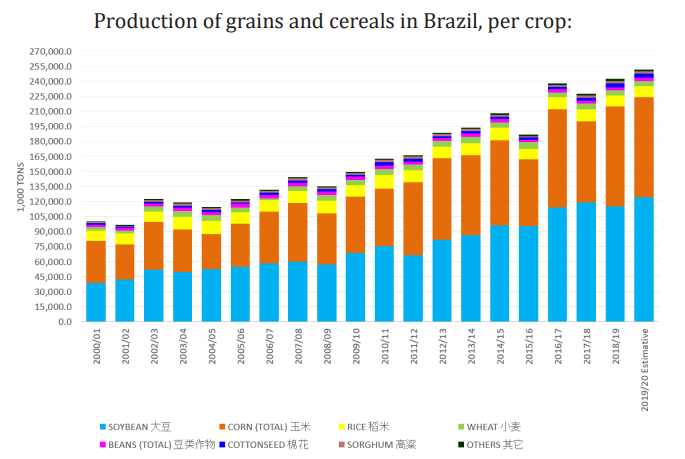Lucilio Rogério Aparecido Alves has a degree in Economic Sciences from the State University of Western Paraná, a master’s and doctorate from the ‘Luiz de Queiroz’ College of Agriculture at the University of São Paulo. He is currently a professor in the Department of Economics, Administration and Sociology at ESALQ, is a researcher at the Center for Advanced Studies in Applied Economics (CEPEA / ESALQ / USP), and wrote this article to AgriBrasilis.
Brazilian agriculture, which involves the agricultural and livestock sectors, has shown an interesting dynamism over the years, increasing the production. This is the result of greater yield, reflecting technological advances in the fields – in the forms of genetics, agrichemical and machinery, which enabled greater production even at decreasing prices – a context observed at a global level. At the same time, national and international demand has been absorbing the Brazilian supply, sustained by the world economy expansion, on the one hand, and by the strengthening of the domestic market, on the other, favored by the country’s economic stability and reduction in inequality.
Greater supply in the farms also contributes to boost agribusiness as a whole. CEPEA (‘Luiz de Queiroz’ College of Agriculture Center for Advanced Studies in Applied Economics at the University of São Paulo) defines agribusiness as an economic sector with links to agriculture, both upstream and downstream,
involving: production of inputs for agriculture, production of agricultural raw materials, processing of these raw materials and distribution and others services until final consumption or export.
Agribusiness is divided into two branches: agriculture and livestock. The agricultural sector corresponds to the set of productive activities of crops and other plant and forestry activities. The livestock sector refers to the set of productive chains of products of animal origin. Each branch consists of four segments, constituting the production chains: Inputs (industrial products used in agriculture and livestock),
Primary (agriculture itself), Agroindustry (agricultural or livestock-based) and Services (transportation, storage, trade and other services linked to agricultural and agroindustrial activities).
According to data from CEPEA, the Gross Domestic Product (GDP) of Brazilian agribusiness represented 21.2% of the total national GDP between 2017 and 2019. Between the years 2000 and 2019, the agribusiness GDP grew at an average rate 0.45% per year, based on the equivalent values of December 2019. Of the total GDP of agribusiness, around 70% refers to agricultural agribusiness (equivalent to 15% of the national GDP) and the other 30% to livestock agriculture (approximately 6.2% of the total Brazilian GDP). However, over the past 20 years, while agricultural GDP has declined at an average rate of 0.19% per year, livestock GDP has shown an average growth of 2.3% per year.
In the agricultural case, even with the drop in added income, production continues growing. In the agriculture, grains and cereals occupy most of the cultivated area in Brazil. Considering the first and second harvests during the summer, almost 65 million hectares are cultivated in Brazil – the second harvest is considered a successor crop from the first harvest; for example, after the soybean harvest, there is the cultivation of a second crop, corn, which represents more than 70% of the national supply. Of the total cultivated area in Brazil, about 3/4 are crops from the first harvest and the remainder are from the second harvest.

Source: CEPEA/ESALQ; Adapted for AgriBrasilis.
Over the past 20 years in Brazil, the area occupied by rice, beans and first-harvest corn has decreased. On the other hand, there have been significant growth in soybean and second harvest corn. However, eight other crops also had area growth, although less intensity. When it comes to productive systems, in the Brazilian Midwest, for example, cotton started to be grown in succession to soybeans in the same season and in the south of the country, areas of rice were replaced by soybean crops.
Between the 2000/01 and 2019/20 harvest years, the area cultivated with grains and cereals in Brazil grew at an average rate of 2.45% per year, however, while first-harvest grew by 1.56% per year, the second harvest showed more intense dynamism, reaching 6.61% per year. In general, despite the fact that second harvest takes place in a less favorable period in terms of climatic conditions, the volumes produced per unit area continue to grow in most harvests. The yield advances of most winter crops and second harvest corn are highlights.
Thus, the growth rate of the total supply is even more expressive. While in the 2000/01 season, 100 million tons of grains and cereals were produced in Brazil, for the 2019/20 harvest there are plans of almost 252 million tons. This growth occurred at an average rate of 5.1% per year. This growth was mainly supported by the higher supply of the second harvest, which went from 10 million tons in 2000/01 to 80 million tons in 2019/20, which means an average growth rate of 11.91% per year. The first harvest supply also grew spectacularly, from 90 million tons to 171.6 million tons in the same period, that is, an average growth of 3.45% per year.
In general, therefore, the supply of grains and cereals in Brazil grew due to the greater use of the soil in regions of farming frontier (with emphasis on the Midwest region) and, especially, with the growth of second harvest crop, meaning that there is an intensification in the use of land and/or adjustments in
production systems, such as increased soybean crops to the detriment of first harvest corn, with corn being sown after soybean harvest.
However, the more intense soil use in two or more crops in the same season raises some questions, such as: How far can the second harvest increase the risks of climatic, phytosanitary and market issues? Does the crops’ succession bring negative impacts into the growth system in long terms? What are the agronomic challenges of the growth systems used today? Is it possible to further increase the yield of the main crops currently grown? At what costs? Given the worsening climate scenario of recent years, is the more intensive use of irrigation feasible? It is increasingly worrying, what impact this would have on the water use?
In addition, it is questioned what mechanisms can be implemented to overcome these challenges that are beyond the control of the individual producer and, therefore, need to have a good quality of agricultural and infrastructure programs and policies.
To support them, research is needed from the economic, financial, agronomic, etc., point of view, especially since there is a lot of progress in land use in the second harvest. As an example, in the Brazilian Midwest, only 45% of the soybean area is used with corn in the second harvest – a large part is fallow and can/ should be used to increase the supply of food to the Brazilian and worldwide populations.

Source: CEPEA/ESALQ; Adapted for AgriBrasilis.

